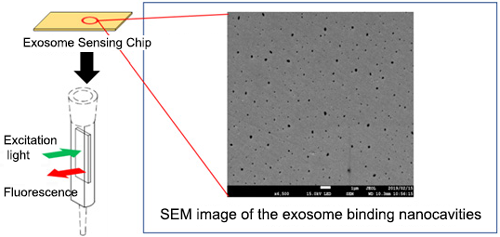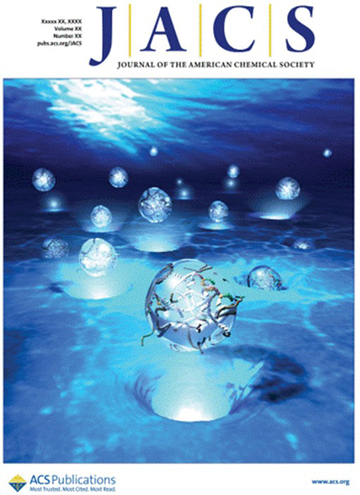Kobe University and System Instruments Co., Ltd. researchers have developed TearExo®; new technology to detect breast cancer using the exosomes found in tears as biomarkers. Exosomes are a subtype of extracellular vesicles (*1).
Research team members included Professor TAKEUCHI Toshifumi (Kobe University Graduate School of Engineering), Project Professor TANINO Hirokazu and Professor SASAKI Ryohei (both of Kobe University Hospital), and Mr HAMADA Kazuyuki (System Instruments Co., Ltd.). This research was mainly conducted by researchers at Kobe University's Medical Device Fabrication Engineering Center (Director: Professor MUKAI Toshiji).
It is hoped that this technology can make a great contribution towards people's health by enabling prompt cancer detection.
This research was first published online on March 10, 2020 in the Journal of the American Chemical Society and was featured on the journal cover.
Main points
- TearExo® uses the world's first chemical nano-processing technology to detect exosomes in a very small amount of bodily fluid, demonstrating extremely high sensitivity and smooth operability, without the need for pretreatments and detection reagents.
- TearExo® enables non-invasive breast cancer testing to be conducted using tear fluid samples that can be easily self-collected by the patient.
- The researchers demonstrated a new liquid biopsy methodology for early cancer detection using the exosomes in tear fluid as biomarkers. This was realized through an 'automatic exosome analyzer'; a highly sensitive assay to measure exosomes, which enables bodily fluid tests to be conducted quickly and easily.
Research Background
Currently, imaging-based screening methods such as mammography are used to detect breast cancer. However, these medical devices are often large and it takes time to obtain the results, as at least two specialists need to interpret the images. This imposes a heavy burden on the patient. Recently liquid biopsies, where the extracellular vesicle exosomes found in patients' bodily fluids are used as biomarkers to detect cancer, have gained attention as a possible alternative. Liquid biopsies are noninvasive and reduce the burden on the patient. It is hoped that they would improve both cancer testing rates and early cancer detection rates.
It has been reported that exosomes are involved in cancer metastasis and malignant development. Therefore exosomes are often the target of liquid biopsies as they are considered to be extremely important markers for diagnosing cancer. However, it is difficult to conduct a prompt analysis using regular exosome analysis methods because they require cumbersome preprocessing. If a new, convenient and highly sensitive method for detecting cancer cell-related exosomes in bodily fluids were to be implemented, it would provide an extremely powerful cancer screening method.
Research Methodology
Principle
TearExo® consists of a fluorescent exosome sensing chip and an automatic exosome analyzer.
The fluorescent exosome sensing chip (Figure 1) was constructed by placing an antibody and a fluorescent reporter molecule in a 100nm nanocavity formed on a glass chip. The antibody recognizes the surface proteins of exosomes and the fluorescent reporter molecule can be used to read the exosomes' binding with the antibody based on changes in the fluorescence. With the automatic exosome analyzer, the researchers achieved a rapid, ultra-sensitive assay (about 1000 times more sensitive than current immunoassays) capable of detecting 50 exosomes in 100µL of fluid in ten minutes, without the need for the lengthy pretreatment required in the past.

Detecting cancer from tear fluid
Tear fluid was sampled from breast cancer patients and healthy donors via Schirmer tests, whereby a small strip of filter paper is used to collect the tear fluid. TearExo® was used to measure the exosomes in these tear fluid samples and analyze the pattern of the surface proteins' composition (principal component analysis). A clear difference was found between the samples obtained from healthy donors and those from breast cancer patients, demonstrating that tear fluid can be used to detect breast cancer (Figure 2).
Exosome composition is different before and after mastectomy; after surgery the composition is the same as that found in healthy people. This shows that TearExo® could also be used to check and monitor patients' post-treatment recovery, as well as for initial cancer detection.
For the first time in the world, this research demonstrated that cancer can be detected using tear fluid.

Further Research
Exosome analysis of clinical samples will be conducted on a larger scale to determine the specificity and sensitivity of this method of breast cancer diagnosis. After that, there are plans to establish a venture company within the next year and apply to Japan's PMDA (Pharmaceuticals and Medicals Device Agency) for the approval of TearExo® as an in vitro diagnostic device.
Glossary
- Exosomes
- Small extracellular exosomes are secreted from various cells into vesicles of around 100 nanometers. They have a varied composition, consisting of nucleic acid and proteins of the cell where they originated. It is thought that by studying exosomes we can find out information about the cells they were secreted from.
- Liquid biopsy
- Less invasive method of diagnosing a patient by measuring biomarkers found in bodily fluids such as blood, tears or urine. The level of diagnosis is equivalent to conventional methods.
Journal Information

- Title
- "Antibody-conjugated signaling nanocavities fabricated by dynamic molding for detecting cancers using small extracellular vesicle markers from tears"
- DOI:10.1021/jacs.9b13874
- Authors
- Takeuchi, T., Mori, K., Sunayama, H., Takano, E., Kitayama, Y., Shimizu, T., Hirose, Y., Inubushi, S., Sasaki, R., Tanino, H.
- Journal
- Journal of the American Chemical Society






